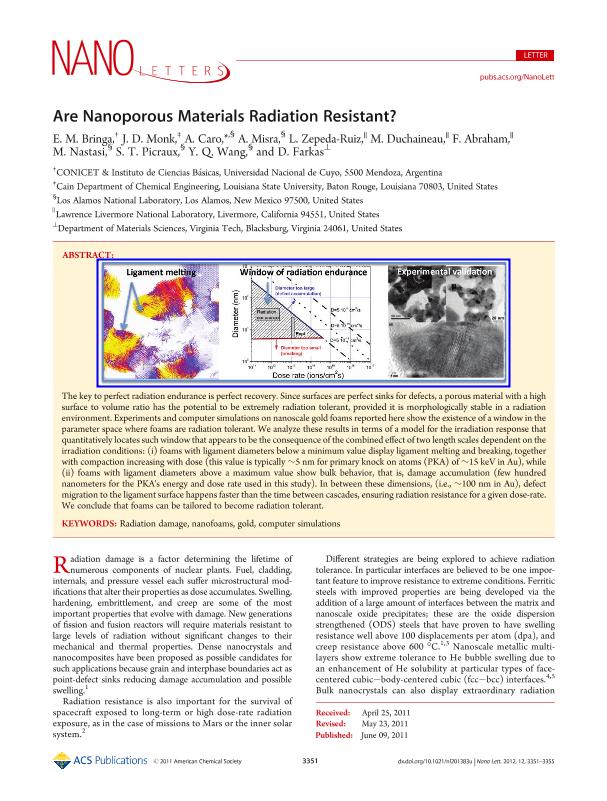Artículo
Are nanoporous materials radiation resistant?
Bringa, Eduardo Marcial ; Monk, J. D.; Caro, A.; Misra, A.; Zepada Ruiz, L.; Duchaineau, M.; Abraham, F.; Nastasi, M.; Picraux, S.T.; Wang, Y.Q.; Farkas, D.
; Monk, J. D.; Caro, A.; Misra, A.; Zepada Ruiz, L.; Duchaineau, M.; Abraham, F.; Nastasi, M.; Picraux, S.T.; Wang, Y.Q.; Farkas, D.
 ; Monk, J. D.; Caro, A.; Misra, A.; Zepada Ruiz, L.; Duchaineau, M.; Abraham, F.; Nastasi, M.; Picraux, S.T.; Wang, Y.Q.; Farkas, D.
; Monk, J. D.; Caro, A.; Misra, A.; Zepada Ruiz, L.; Duchaineau, M.; Abraham, F.; Nastasi, M.; Picraux, S.T.; Wang, Y.Q.; Farkas, D.
Fecha de publicación:
09/06/2011
Editorial:
American Chemical Society
Revista:
Nano Letters
ISSN:
1530-6984
Idioma:
Inglés
Tipo de recurso:
Artículo publicado
Clasificación temática:
Resumen
The key to perfect radiation endurance is perfect recovery. Since surfaces are perfect sinks for defects, a porous material with a high surface to volume ratio has the potential to be extremely radiation tolerant, provided it is morphologically stable in a radiation environment. Experiments and computer simulations on nanoscale gold foams reported here show the existence of a window in the parameter space where foams are radiation tolerant. We analyze these results in terms of a model for the irradiation response that quantitatively locates such window that appears to be the consequence of the combined effect of two length scales dependent on the irradiation conditions: (i) foams with ligament diameters below a minimum value display ligament melting and breaking, together with compaction increasing with dose (this value is typically ∼5 nm for primary knock on atoms (PKA) of ∼15 keV in Au), while (ii) foams with ligament diameters above a maximum value show bulk behavior, that is, damage accumulation (few hundred nanometers for the PKA's energy and dose rate used in this study). In between these dimensions, (i.e., ∼100 nm in Au), defect migration to the ligament surface happens faster than the time between cascades, ensuring radiation resistance for a given dose-rate. We conclude that foams can be tailored to become radiation tolerant.
Palabras clave:
Radiation Damage
,
Nanofoams
,
Gold
,
Computer Simulations
Archivos asociados
Licencia
Identificadores
Colecciones
Articulos(CCT - MENDOZA)
Articulos de CTRO.CIENTIFICO TECNOL.CONICET - MENDOZA
Articulos de CTRO.CIENTIFICO TECNOL.CONICET - MENDOZA
Citación
Bringa, Eduardo Marcial; Monk, J. D.; Caro, A.; Misra, A.; Zepada Ruiz, L.; et al.; Are nanoporous materials radiation resistant?; American Chemical Society; Nano Letters; 12; 7; 9-6-2011; 3351-3355
Compartir
Altmétricas



